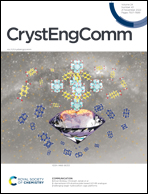I⋯N halogen bonding in 1 : 1 co-crystals formed between 1,4-diiodotetrafluorobenzene and the isomeric n-pyridinealdazines (n = 2, 3 and 4): assessment of supramolecular association and influence upon solid-state photoluminescence properties†
Abstract
1 : 1 co-crystals formed between 1,4-diiodotetrafluorobenzene and each of the three isomeric n-pyridinealdazines (n = 2, 3 and 4) have been characterised by X-ray crystallography, a variety of spectroscopic methods, viz. IR, Raman, NMR: solution- and solid-state (13C CP MAS and 13C HPDEC MAS) and fluorescence as well as by computational chemistry techniques. The primary connection between the respective coformers arises from I⋯N halogen bonds which give rise to one-dimensional supramolecular chains of varying topology depending on the position of the nitrogen atom in the n-pyridinealdazine isomer. The energies calculated for the I⋯N contacts are relatively small, varying from −5.4 to −6.3 kcal mol−1, with the maximum being in the crystal of the n = 3 isomer. Notable in the molecular packing are C–I⋯π(pyridine) and C–F⋯π(arene) interactions in the crystals with the 3- and 4-pyridinealdazine coformers, respectively. The co-crystal formed by 2-pyridinealdazine exhibited fluorescence emission.



 Please wait while we load your content...
Please wait while we load your content...